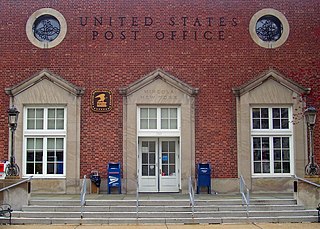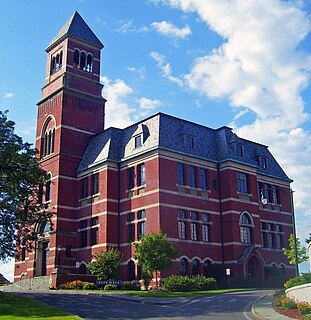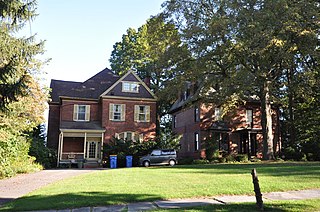
Peace Dale is a village in the town of South Kingstown, Rhode Island. Together with the village of Wakefield, it is treated by the U.S. Census as a component of the census-designated place identified as Wakefield-Peacedale, Rhode Island.

The Delaware and Hudson Canal was the first venture of the Delaware and Hudson Canal Company, which would later build the Delaware and Hudson Railway. Between 1828 and 1899, the canal's barges carried anthracite coal from the mines of Northeastern Pennsylvania to the Hudson River and thence to market in New York City.

Ezra Hasbrouck Fitch was the co-founder of the modern lifestyle brand Abercrombie & Fitch and is attributed with the introduction of Mahjong to the United States.

Rondout, is situated on the Hudson River, at the mouth of Rondout Creek. Originally a maritime village, the arrival of the Delaware and Hudson Canal helped create a city that dwarfed nearby Kingston. Rondout would become the third largest port on the Hudson River. Rondout merged with Kingston in 1872. It now includes the Rondout-West Strand Historic District.

The U.S. Post Office in Rhinebeck, New York serves the 12572 ZIP Code. It is located on Mill Street just south of the intersection with NY 308 at the center of the village.

The Rhinebeck Village Historic District is located along US 9 and NY 308 in Rhinebeck, New York, United States. It is an area of 167 acres (68 ha) contains 272 buildings in a variety of architectural styles dating from over 200 years of the settlement's history. It was recognized as a historic district and added to the National Register of Historic Places in 1979 as a cohesive area of preserved historic buildings.
Abercrombie & Fitch (A&F) is an American lifestyle retailer that focuses on casual wear. Its headquarters are in New Albany, Ohio. The company operates three other offshoot brands: Abercrombie Kids, Hollister Co., and Gilly Hicks. As of February 2020, the company operated 854 stores across all brands.

The U.S. Post Office in Mineola, New York serves the ZIP Code 11501, covering that community in the Towns of North Hempstead and Hempstead, New York, United States, the seat of Long Island's Nassau County. It is located on the northeast corner of the junction of First and Main Streets.

The Old Dutch Church, officially known as the First Reformed Protestant Dutch Church of Kingston, is located on Wall Street in Kingston, New York, United States. Formally organized in 1659, it is one of the oldest continuously existing congregations in the country. Its current building, the fifth, is an 1852 structure by Minard Lafever that was designated a National Historic Landmark in 2008, the only one in the city. The church's 225-foot (69 m) steeple, a replacement for a taller but similar original that collapsed, makes it the tallest building in Kingston and a symbol of the city.

Rondout Light is a lighthouse on the west side of the Hudson River at Kingston, New York.
Bluestone Group is a financial services and technology business with offices in the UK and Ireland.

The City Hall building in Kingston, New York, United States, is located on Broadway in the center of the city. It is a red brick building in a late Victorian architectural style dating from 1873.

The former Kingston City Library building is located on Broadway in the center of Kingston, New York, United States. It is a brick Carnegie library built in 1903 in the Classical Revival architectural style.

The Kingston Stockade District is an eight-block area in the western section of Kingston, New York, United States, commonly referred to as Uptown Kingston. It is the original site of the mid-17th century Dutch settlement of Wiltwyck, which was later renamed Kingston when it passed to English control.

The James and Mary Forsyth House is located on Albany Avenue near uptown Kingston, New York, United States. It is a brick Italian villa-style house designed by Richard Upjohn in the mid-19th century. When it was finished it was celebrated locally for its lavish decor. James Forsyth, as well as another later resident, left the house after being accused of financial wrongdoing. It has been modified slightly since its original construction with trim in the Colonial Revival style.

The Galli-Curci Theatre is located on Main Street in Margaretville, New York, United States. It is a brick building erected in the 1920s, now primarily used as a store, although some of the original theater remains. It was named after opera singer Amelita Galli-Curci, who summered at her historic country estate near Margaretville from 1922-1937 and sang at its opening night.

Chestnut Street Historic District is a national historic district located at Kingston in Ulster County, New York. The district includes 44 contributing buildings and six contributing structures. It comprises a collection of substantial 19th and early 20th century residences on dramatic hillside sites. It also includes the Immanuel Lutheran Church and Bruck Funeral Home.

Kingston is a city in and the county seat of Ulster County, New York, United States. It is 91 miles (146 km) north of New York City and 59 miles (95 km) south of Albany. The city's metropolitan area is grouped with the New York metropolitan area around Manhattan by the United States Census Bureau. The population was 24,069 at the 2020 United States Census.

The earliest stage of skyscraper design encompasses buildings built between 1884 and 1945, predominantly in the American cities of New York and Chicago. Cities in the United States were traditionally made up of low-rise buildings, but significant economic growth after the Civil War and increasingly intensive use of urban land encouraged the development of taller buildings beginning in the 1870s. Technological improvements enabled the construction of fireproofed iron-framed structures with deep foundations, equipped with new inventions such as the elevator and electric lighting. These made it both technically and commercially viable to build a new class of taller buildings, the first of which, Chicago's 138-foot (42 m) tall Home Insurance Building, opened in 1885. Their numbers grew rapidly, and by 1888 they were being labelled skyscrapers.

Santa Claus was a sidewheel passenger-and-freight steamboat built in 1845 for service on the Hudson River between Wilbur, New York, and New York City. In her first few years of operation, Santa Claus saw service on a number of different Hudson River routes, most notably between Albany and New York City. She was also employed from time to time as an excursion steamer. A highlight of her career occurred in 1852, when she had the honor of conveying the remains of American statesman Henry Clay from New York City to Albany en route to their final resting place.

















